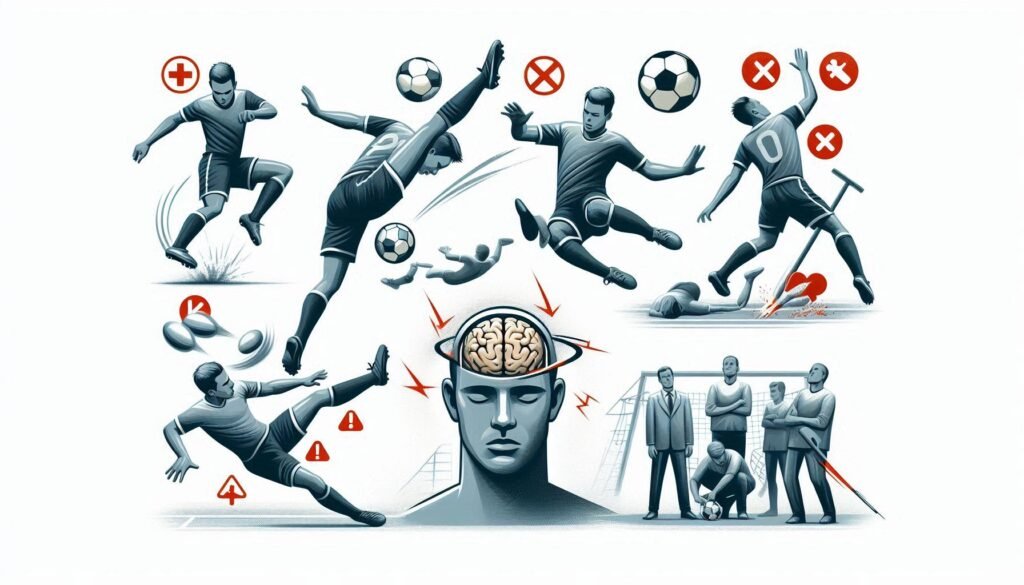When we think of sports, the first images that often come to mind are those of intense contact and high-impact collisions. However, even non-contact sports can pose significant risks for concussions. Many athletes participate in these activities believing they’re safe from injury, but hidden dangers lurk beneath the surface. Understanding how seemingly low-risk sports can lead to serious head injuries is crucial for athletes, coaches, and parents alike.
From gymnasts executing aerial maneuvers to soccer players striking headers with forceful precision, every movement carries its own set of challenges. As awareness grows about concussion risks in various sporting scenarios, it’s essential to shed light on these overlooked aspects of non-contact athletics. Join us as we explore the unexpected hazards associated with non-contact sports and what you need to know to stay informed and safe on the field or court.

Identifying Concussion Hazards in Seemingly Low-Risk Sports
Non-contact sports often give a false sense of security regarding injury risks. Many participants assume that without physical contact, the likelihood of concussions is minimal. However, this misconception can lead to dangerous situations.
Athletes in these sports frequently engage in high-intensity activities that involve quick movements and complex maneuvers. These actions can create opportunities for falls or awkward landings, leading to head injuries even in the absence of direct impact with another player.
Moreover, environmental factors play a significant role in increasing concussion risks. Slippery surfaces or uneven playing fields can contribute to accidents that result in head trauma during seemingly safe events.
Awareness is crucial for identifying potential hazards associated with non-contact sports. Athletes should be educated about their sport’s specific risks and encouraged to prioritize safety measures at all times. Understanding these dangers allows teams and individuals to take proactive steps toward minimizing concussion occurrences effectively.
Gymnastics and Cheerleading: Hidden Dangers of Aerial Maneuvers
Gymnastics and cheerleading are often seen as graceful, low-contact activities. However, they come with significant concussion risks due to their reliance on aerial maneuvers. Athletes frequently perform flips, twists, and other high-flying stunts that can lead to falls or awkward landings.
The impact of a fall from height can be severe. A miscalculation during a routine may result in landing incorrectly, which could easily cause head injuries. Even experienced gymnasts face these risks when pushing themselves to achieve new skills.
Moreover, the dynamics of teamwork play a crucial role in cheerleading. When one member falters or loses balance mid-air during a stunt sequence, it puts everyone involved at risk for injury. Communication is vital but not always flawless under pressure.
Coaches must emphasize safe practices and proper techniques to mitigate these dangers. Regular training sessions focused on spotting techniques can also help prevent accidents and ensure athletes remain alert while performing complex routines.
Soccer Headers: Debating the Long-Term Impact on Brain Health
Soccer, while often regarded as a non-contact sport, presents unique risks, particularly related to headers. Players frequently use their heads to direct the ball, leading to concerns about potential brain injuries. Studies suggest that repetitive heading may contribute to long-term cognitive issues.
Research indicates that even moderate impacts from headers can cause microtrauma in brain tissue. This raises questions about the cumulative effects over years of play. Many former players report symptoms resembling those of concussions despite never experiencing a diagnosed head injury.
Youth athletes are at increased risk due to developing brains. Coaches and parents must consider these factors when training young players. The debate surrounding soccer headers has sparked discussions among health professionals, trainers, and sports organizations alike.
Some leagues have begun implementing guidelines around heading practices for younger age groups. Awareness is key in addressing this issue as more studies emerge on how these seemingly benign actions might affect brain health down the line.
Basketball and Volleyball: Collision and Fall Risks on the Court
Basketball and volleyball are often categorized as non-contact sports, but this can be misleading. Players frequently encounter situations that lead to collisions or falls during gameplay. Quick movements, sudden stops, and aerial jumps all contribute to the potential for injury.
In basketball, players must navigate a crowded court filled with teammates and opponents alike. As they drive toward the hoop or attempt a defensive play, unintentional contact can occur. This increases the risk of concussions from impacts with other players or even falling awkwardly on the court surface.
Similarly, in volleyball, athletes leap high to make spikes or blocks. When two players collide mid-air while attempting to reach for the ball, serious injuries may result. The landing phase also poses risks; improper landings can cause head trauma if a player hits their head on the floor.
Both sports require heightened awareness of surroundings and agility in movement. By understanding these risks better, athletes can take proactive steps to protect themselves while enjoying these dynamic games.
Track and Field Events: Unexpected Concussion Scenarios
Track and field events are often perceived as low-risk activities, but they can present unexpected concussion scenarios. Runners may collide during close races or while jostling for position on the track. A sudden bump can lead to falls that result in head injuries.
Field events like pole vaulting introduce unique risks as well. Athletes who miscalculate their jumps might fall awkwardly, potentially striking their heads on the ground or equipment. These incidents highlight how even a momentary lapse in concentration can have serious consequences.
Throwing events also carry hidden dangers. Discus and javelin throwers need ample space, but an errant throw could hit nearby athletes or spectators. Injuries from flying objects aren’t common, but when they occur, concussions can be a significant risk.
Environmental factors play a role too. Uneven surfaces or poor weather conditions may cause athletes to slip or trip unexpectedly. Such mishaps underscore the importance of vigilance in all aspects of training and competition within track and field sports.
The Role of Playing Surfaces in Non-Contact Sport Concussions
The playing surface can significantly influence the risk of concussions in non-contact sports. Different materials, whether grass, turf, or hardwood, offer varying levels of shock absorption. A harder surface may increase the chance of head impacts during falls or collisions.
Artificial turf has gained popularity for its durability and lower maintenance costs. However, it often lacks the cushioning found in natural grass. This can lead to more severe impacts when athletes take a spill or collide with others on the field.
Similarly, gymnasts and cheerleaders frequently encounter injury risks from their landing surfaces. Hard mats might not provide adequate protection against falls from heights during tricks and stunts. The type of flooring plays a crucial role in mitigating these risks.
Coaches should assess playing conditions regularly to ensure athlete safety. Awareness about how different surfaces affect concussion susceptibility is essential for preventing injuries in non-contact sports.
Equipment Malfunction and Environmental Factors Contributing to Injuries
Equipment malfunction can happen in any sport, including non-contact activities. When gear fails, athletes are at a heightened risk for injuries. For example, a faulty trampoline in gymnastics can lead to unexpected falls that result in concussions.
Environmental factors also play a crucial role. Poorly maintained surfaces, like uneven tracks or slippery gym floors, increase the likelihood of accidents. Wet conditions or debris on the playing area can disturb an athlete’s balance and cause them to fall awkwardly.
Additionally, inadequate safety equipment further raises risks. Helmets and pads are essential but often ignored in sports like cheerleading and track events where they may not seem necessary. Yet these simple tools could prevent serious head injuries during mishaps.
Weather conditions should not be underestimated. Extreme heat can affect focus and coordination while cold temperatures might make surfaces more hazardous as ice forms unnoticed. Being aware of these elements is vital for reducing concussion risks even in seemingly safe environments.
Importance of Proper Technique in Preventing Non-Contact Sport Concussions
Proper technique is crucial in minimizing the risk of concussions, even in non-contact sports. Athletes must be trained to execute movements that prioritize safety and stability. For instance, gymnasts should focus on landing correctly to reduce impact forces on their heads.
Coaches play a vital role by teaching athletes how to perform skills efficiently while maintaining control over their bodies. Emphasizing good posture and balance can significantly decrease the likelihood of falls or awkward landings during practice or competition.
In sports like soccer, proper heading techniques can mitigate risks associated with repeated impacts. Educating players about appropriate body positioning when executing headers helps protect the brain from injury.
Fostering an environment where athletes feel comfortable seeking help for poor technique is essential. Encouraging open communication allows young athletes to learn healthier habits that will serve them throughout their sporting careers and beyond.
Implementing Concussion Protocols in Non-Contact Sports Programs
Implementing concussion protocols in non-contact sports programs is essential for protecting athletes. These protocols provide a structured approach to identifying, assessing, and managing concussions. Start by creating clear guidelines on when an athlete should be removed from play due to potential head injuries.
Training staff and coaches on recognizing the signs of a concussion is crucial. They need to understand symptoms that may not be immediately visible, such as confusion or balance issues. Regular training sessions can ensure that everyone involved knows their responsibilities.
Communication with parents and guardians also plays a vital role in this process. Keeping them informed about the risks associated with non-contact sports can foster a culture of safety within the community.
Implementing return-to-play strategies is equally important. Athletes should only resume activities after medical clearance, ensuring their health remains the top priority throughout their sporting journey.
Raising Awareness: Educating Athletes, Coaches, and Parents
Raising awareness about non-contact sports and concussion risks is crucial. Education is a powerful tool that can help prevent injuries before they occur. Athletes, coaches, and parents should be informed about the potential hazards in seemingly low-risk sports.
Workshops and training sessions can provide valuable insights into recognizing concussion symptoms. Coaches play a key role in implementing safety protocols during practices and games. They must understand how to spot signs of head trauma early on.
Parents also have an integral part to play. Open communication with their children about what constitutes safe behavior on the field or court encourages mindfulness among young athletes.
Furthermore, sharing resources like videos or articles on proper techniques can enhance understanding of safe practices in each sport. Building a culture of safety promotes proactive measures rather than reactive responses when injury occurs.
By working together, we can create an environment where athletes are educated about their health while enjoying the thrill of competition without unnecessary risk factors involved. Awareness truly makes all the difference when it comes to protecting our youth from the dangers associated with concussions in non-contact sports.

